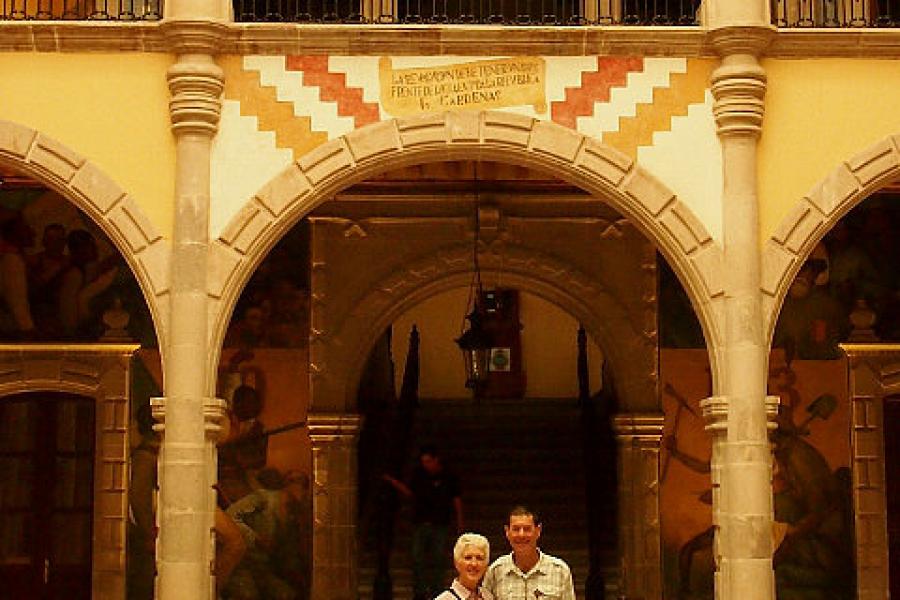Zacatecas and the Masks (Originally posted 26 Nov 2014)
Country
We lingered on in Durango for a further day, slept late, caught the cable car up a nearby hill to take in the city, walked 300m through an underground tunnel between the main square and the minerals museum, visited the Museum of Francisco (Pancho) Villa and enjoyed a cheap dinner of the local speciality, gorditas. It was somewhere during our idle day that I checked my email back at our hotel and discovered to my dismay that we needed to go to Guatemala. Exactly why is a much longer story but suffice it to say we need to export Elephant from Mexico. I will go into this story a little more (very little more) later.
As Guatemala is 2000km south of Durango, this meant a change of plans. So, with a few hours work on the maps, we struck out south to Zacatecas whose historic centre has been listed by UNESCO as a World Heritage site. We had a good run down with little traffic but arrived just at the wrong time of day. In Mexico the wrong time is just as workers and school kids head home for a long lunch and siesta before emerging in the evening for another round of work or shopping. To make matters worse, we arrived on 20 November, the actual day of remembrance for the Revolution when some of the streets in this narrow, contorted, cobbled city built in a gully, were closed for celebrations.
Forty minutes in a traffic jam on the steep cobbled streets and Elephant's clutch was burning and the mahout was short of good will towards his fellow man and in bad need of a piss. Eventually, we found a place to pull out of the traffic and I paid the 15 Pesos entry fee at an excellent art museum to get inside and use the gents. All of which allowed Elephant to cool down and the lunch time traffic to subside. We set off again and with the sort of luck born of long experience and a little good planning, found a nice hotel in the middle of this interesting town.
The historic centre of Zacatecas is listed as a World Heritage site by UNESCO and it is a status it richly deserves. Established in the 16th Century, the city grew wealthy on the rich mines that surrounded the town and gave it a reason to exist. By the time that Royal Navy retread James Cook was sailing up the east coast of Terra Australis, Zacatecas was a wealthy, sophisticated city of beautiful buildings and shady plazas. And, while the old city was small enough to walk around in a couple of determined hours, we spent two days stomping up and down its steep hills just to see the highlights.
The city has a magnificent “exuberant” Baroque cathedral with a facade so intricately carved that we spent a half hour standing on the pavement opposite picking out the finer detail. The Cathedral replaced an original parish church and was built over a 100 year period and has been remodelled several times since its consecration in 1841. As a consequence it reflects a number of architectural styles with the interior a complete contrast to the exterior.
As magnificent as we found the Cathedral, it was not our favourite Zacatecas experience. That award goes to the Museum of Rafael Coronel, which is well known for its collection of 5000 masks. Masks have been important in Mexican culture since pre-historic times and feature in all manner of celebrations. The museum had thousands of examples and the few selected for the photo spread hardly do justice to the whole. Even with our minimal understanding of the cultural importance of the masks, the 30 Pesos entry fee was money well spent.
With our southern imperative now pressing, we chose a long day on the toll roads to transit to the city of Morelia as quickly as possible. It was one of those days we set about with grim determination. One of those days we just get done. A bit like a 10 hour visit to the dentist. Our long haul along the tollroads did, however, have one important benefit. We swept through the edge of Mexico's heartland, past broad acre farming on an industrial scale, past factories large and small and industrial cities and towns, gritty, tough and aspiring. At one point the tollroad passed a single car factory. At 80 km/h it took more than 5 minutes to pass. Other factories produced electronics, textiles, control systems,and earth moving machinery. New suburbs spread out into the countryside. The workers' suburbs were of small block houses in neat rows, painted bright colours and each with its large plastic water tank on the roof. The new middle class suburbs spread up the hills in a jumble of sparkling new villas in more earthy and subdued colours. This was the new Mexico. The world's 13th largest economy.





















